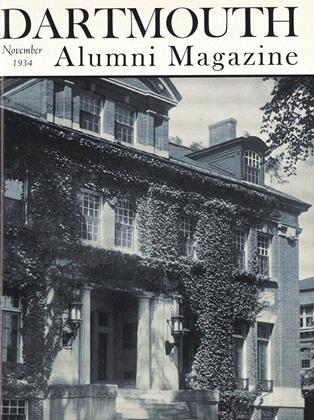The regular classroom work of the school is now in full swing after the completion of the summer surveying season, which wound up with the building of a short-cut, if somewhat circuitous, railway line from the Hanover-West Lebanon road across the fields to Lebanon St. opposite the football field. For practical purposes the railway line was transformed to a highway at the last minute.
An introductory course, reviewing the prerequisite work studied in the College, such as physics, chemistry, mathematics, was presented to the entering class prior to the beginning of the regular first-year schedule. The suggestion that the fundamental principles outlined in these courses might be correlated in any way and applied to the solution of actual engineering problems came as a distinct shock to most of the students.
Your correspondent spent a couple of days in the testing laboratory of the Columbia Engineering School in September. Professor Krefeld, who is in charge of the materials testing at Columbia, spared no pains to show me the operation of his laboratory and explain the work which they give their students. The information which Professor Krefeld offered will be of great value to us in expanding the work which we can offer our classes in materials and strength of materials. Incidentally, the complete co-operation and lack of professional jealousy encountered in the academic field are mighty gratifying.
M. H. Hoyt '97 of Philadelphia paid the school his first visit since graduation, one day last month.
Similarly, Paul Knowles '29 dropped in last month. Paul is married, has one child, and H selling for the Falk Co. with his headquarters in Chicago. This was Paul's first visit since he left in 1929.
George Simpson '30 has been working on the new air commuters' seaplane ramps in New York, for the New York Dock Dept.
A news item received late in the spring informed us in glaring headlines "5 DEBUTANTES BAIL OUT LEAKY BOATWITH BIG HATS, Escorts Help WieldMillinery in Rescue at Fair." There were no casualties, and listed as one of the escorts was Fred Slaughter. The locale and circumstances place grave suspicion on Fred Slaughter '32.
Professor Fletcher is back in Hanover, after a summer in White Plains, with his usual keen interest in the affairs of the school. So many alumni ask for him that I am quoting here a letter received from him by Dean Garran late last summer:
"The volume on the Catskill Aqueduct,which you noted, is the one I had in mind.J. Waldo Smith was the master-spirit whoconceived and accomplished the construction of that greatest aqueduct in the world,but he did not write the book. You mayremember the tribute paid to his memoryafter his death, which was only recent.
"Trow (T.S.C.E.) 1895 kindly loaned metwo official descriptions of the entire work,since which we have made a second trip tothe Ashokan reservoir. A survey of all theworks (dams, dikes, etc.) along five or sixmiles of the 'front'; then we visited the biggatehouse (which, incidentally, is a hydroelectric power house, exclusively for thecontrol of the entire aqueduct) and interviewed Mr. Dudley, the superintendent,who has been on the works 29 years, sinceThe first shovelful of earth was thrown out.He made us wise concerning the variouscontrol-gates and structures deep downbeneath the floor, the automatic recordingdevices, etc., zuhich regulate the operationof the entire aqueduct. A given volume ofwater flows therein, 120 miles in three days.The round trip of 245 miles was made inone day,—13 1/2 hours absent from home.
"We have also visited the great dam ofthe Wenaque reservoir 6 to 7 miles long,which serves the city of Newark and sevenadjoining municipalities. Here the Superintendent gave our party facilities, inside andoutside the headworks building, including, on an evening, the grand illumination of the plaza and the exhibition of fivefountains of jets which were illuminatedby scores of submerged bulbs (lamps electrical) xuhich made the jets display a playof colors alternating between red, blue,green, and yellow.
"Our trips over northern New Jersey andeastern New York state have accumulatedabout 1200 miles of mileage."
 View Full Issue
View Full Issue
More From This Issue
-
 Article
ArticleGRADUS AD PAMPASSUM
November 1934 By The Editors -
 Article
ArticleHANOVER BROWSING
November 1934 By Herbert F. West '22 -
 Class Notes
Class NotesClass of 1930
November 1934 By Albert I. Dickerson -
 Class Notes
Class NotesClass of 1934
November 1934 By Martin J. Dwyer Jr. -
 Class Notes
Class NotesClass of 1929
November 1934 By F. William Andres -
 Class Notes
Class NotesClass of 1914
November 1934 By Edward Leech








